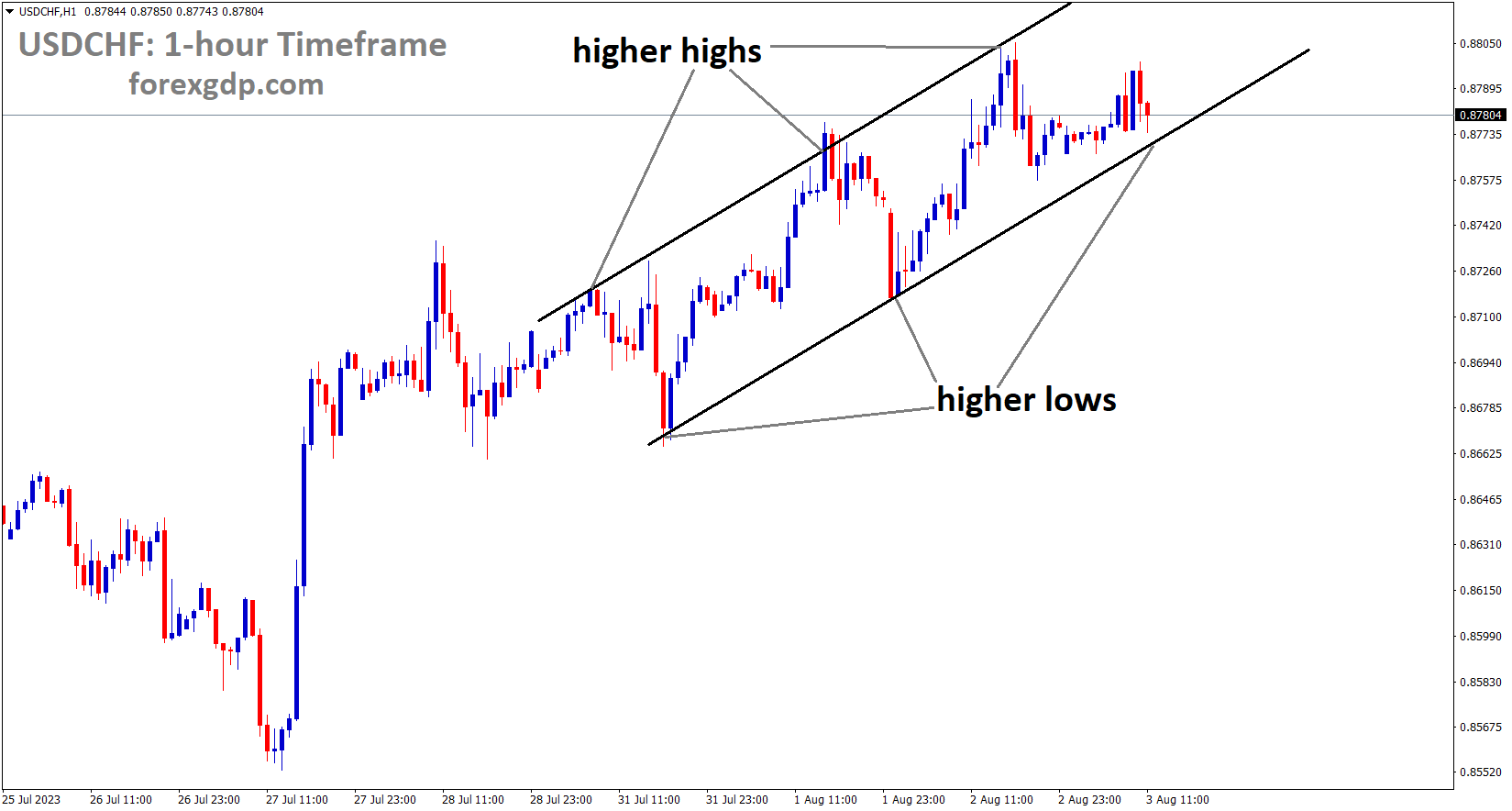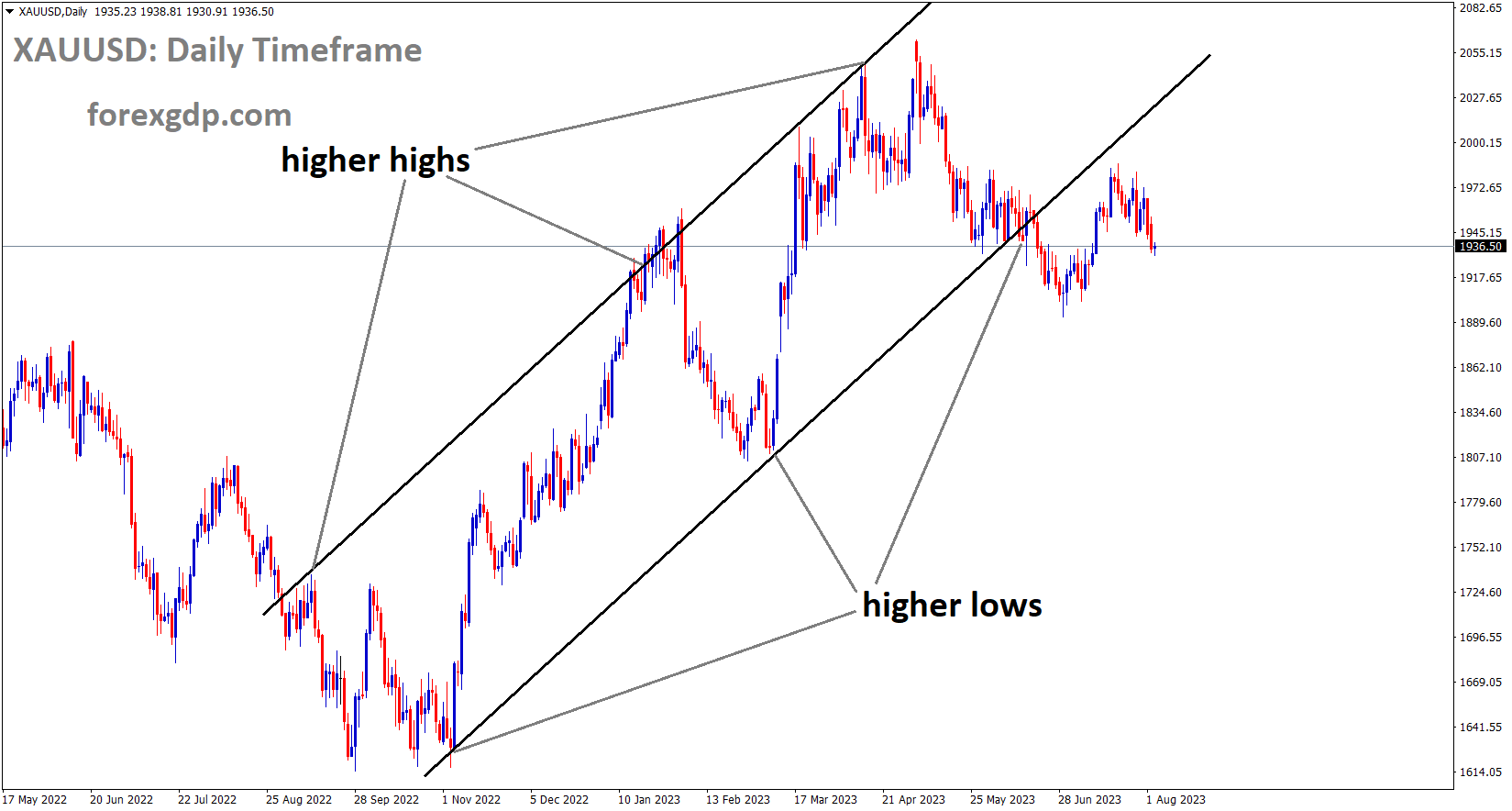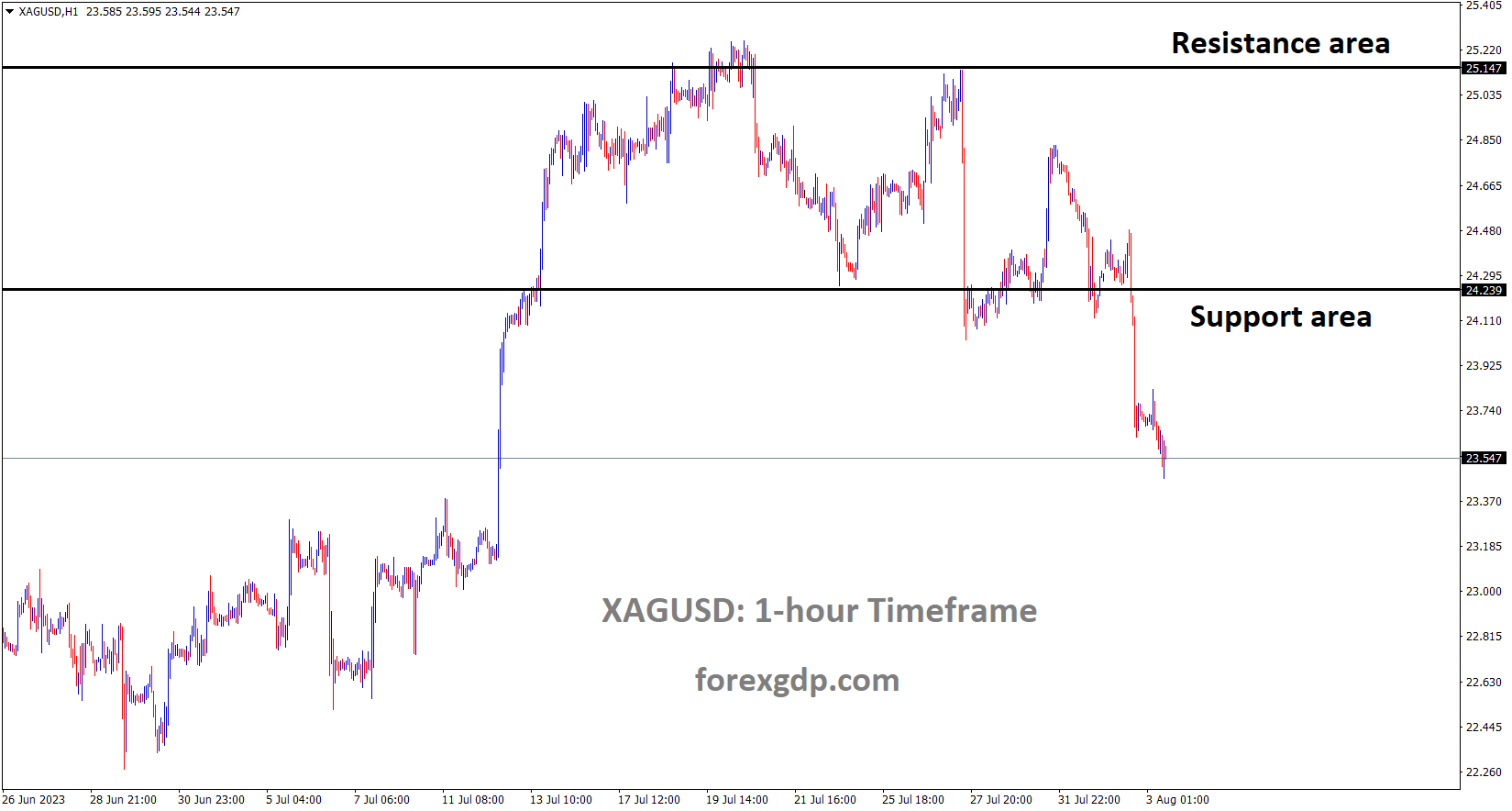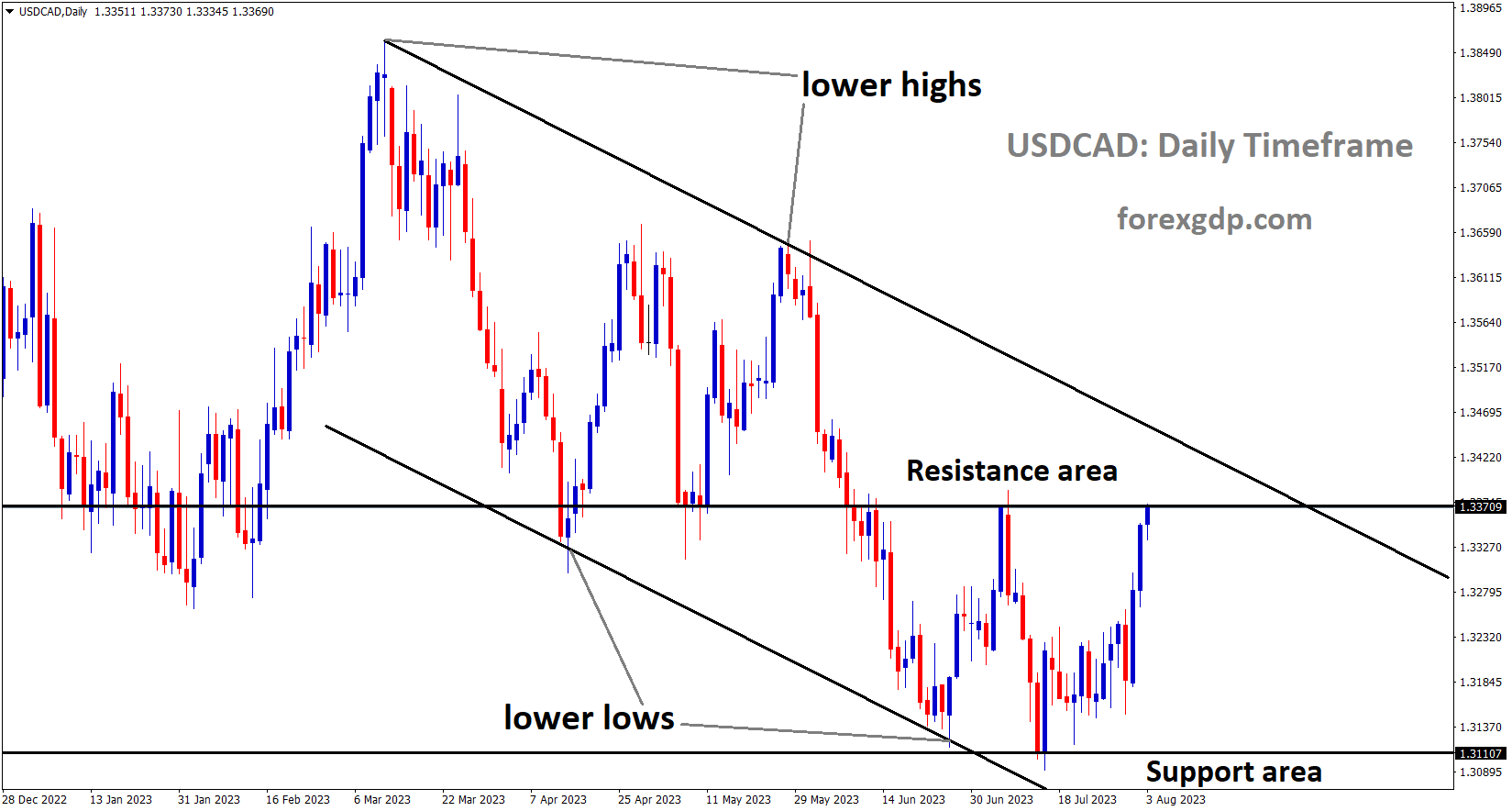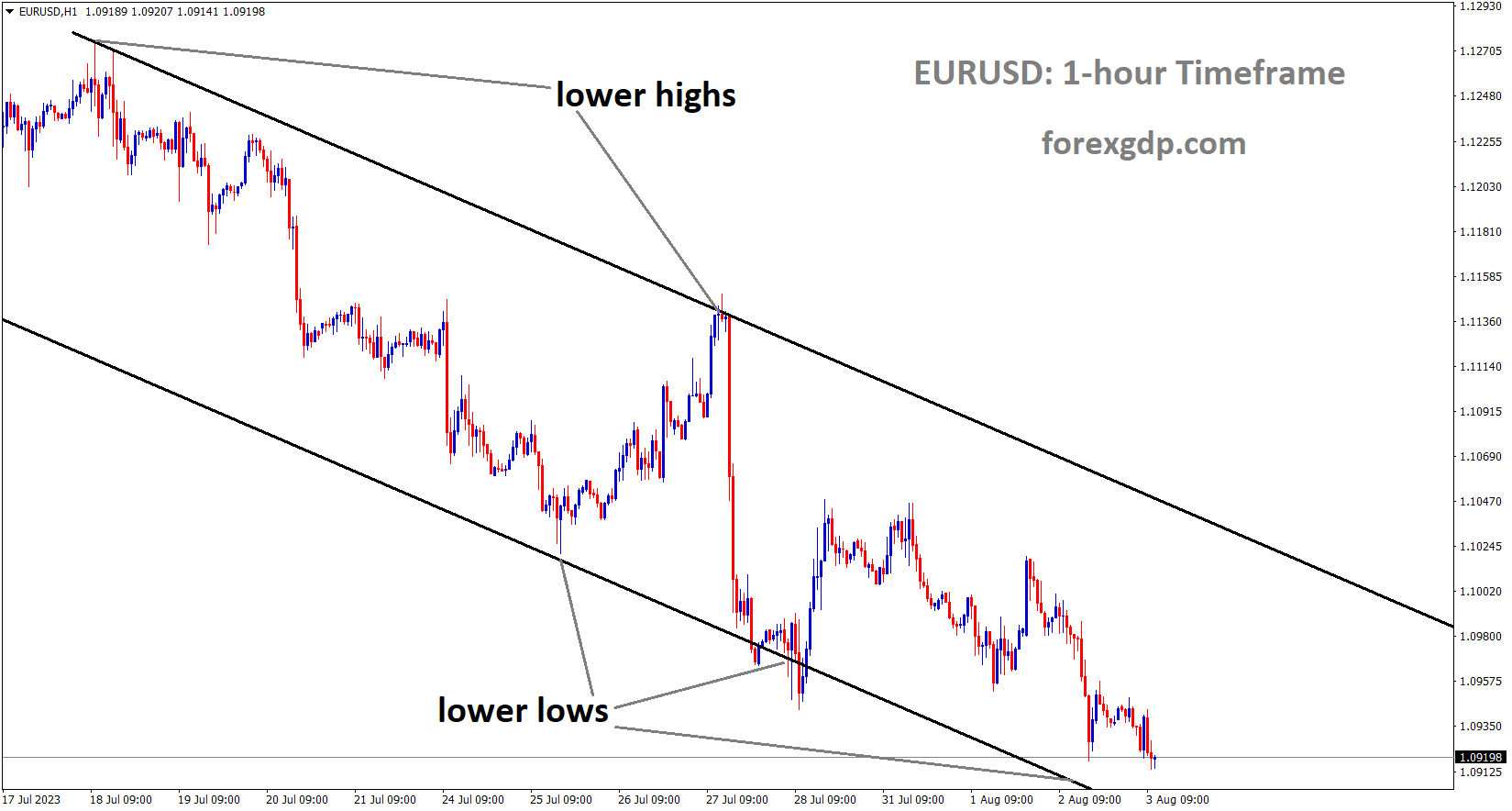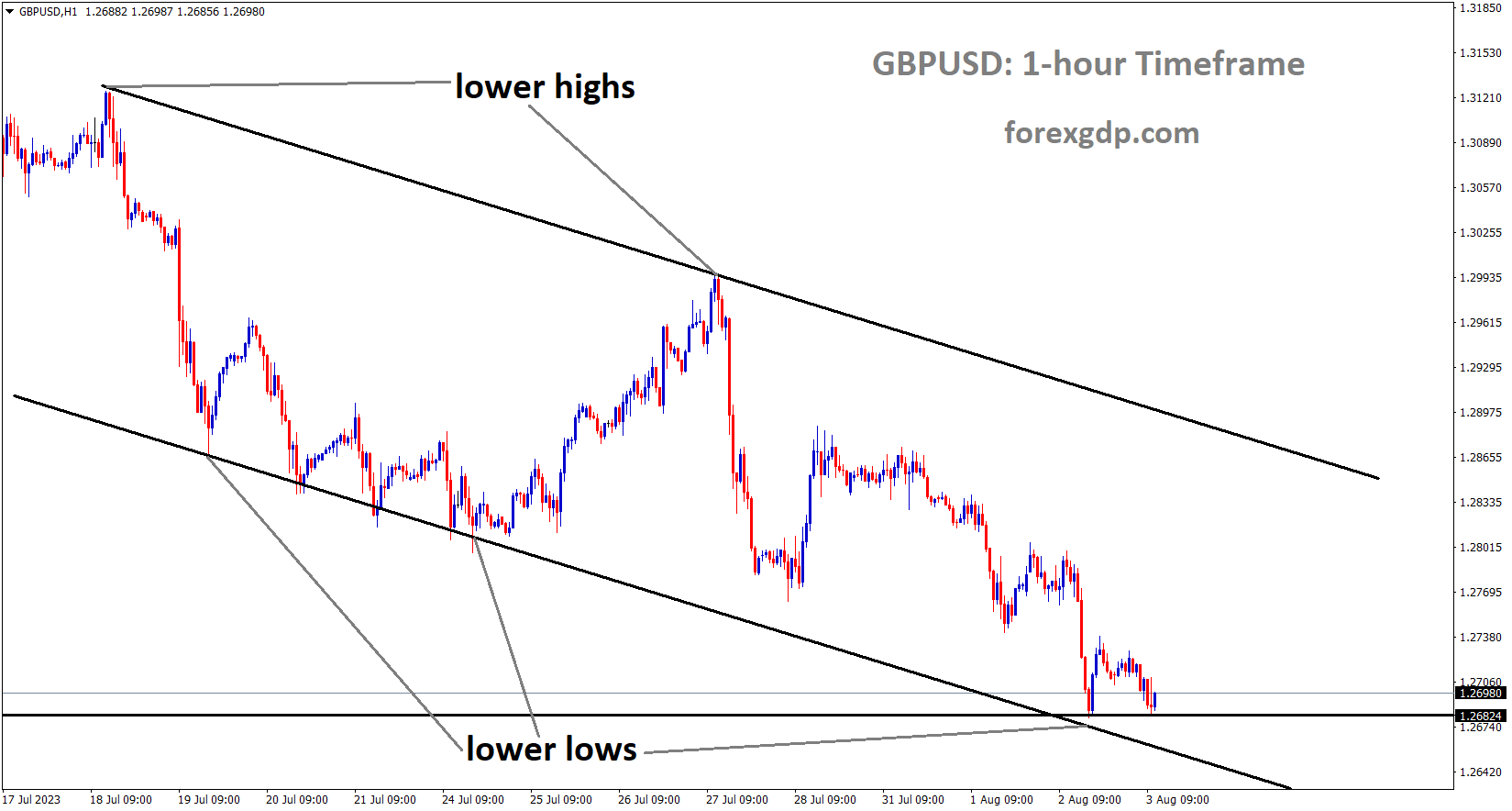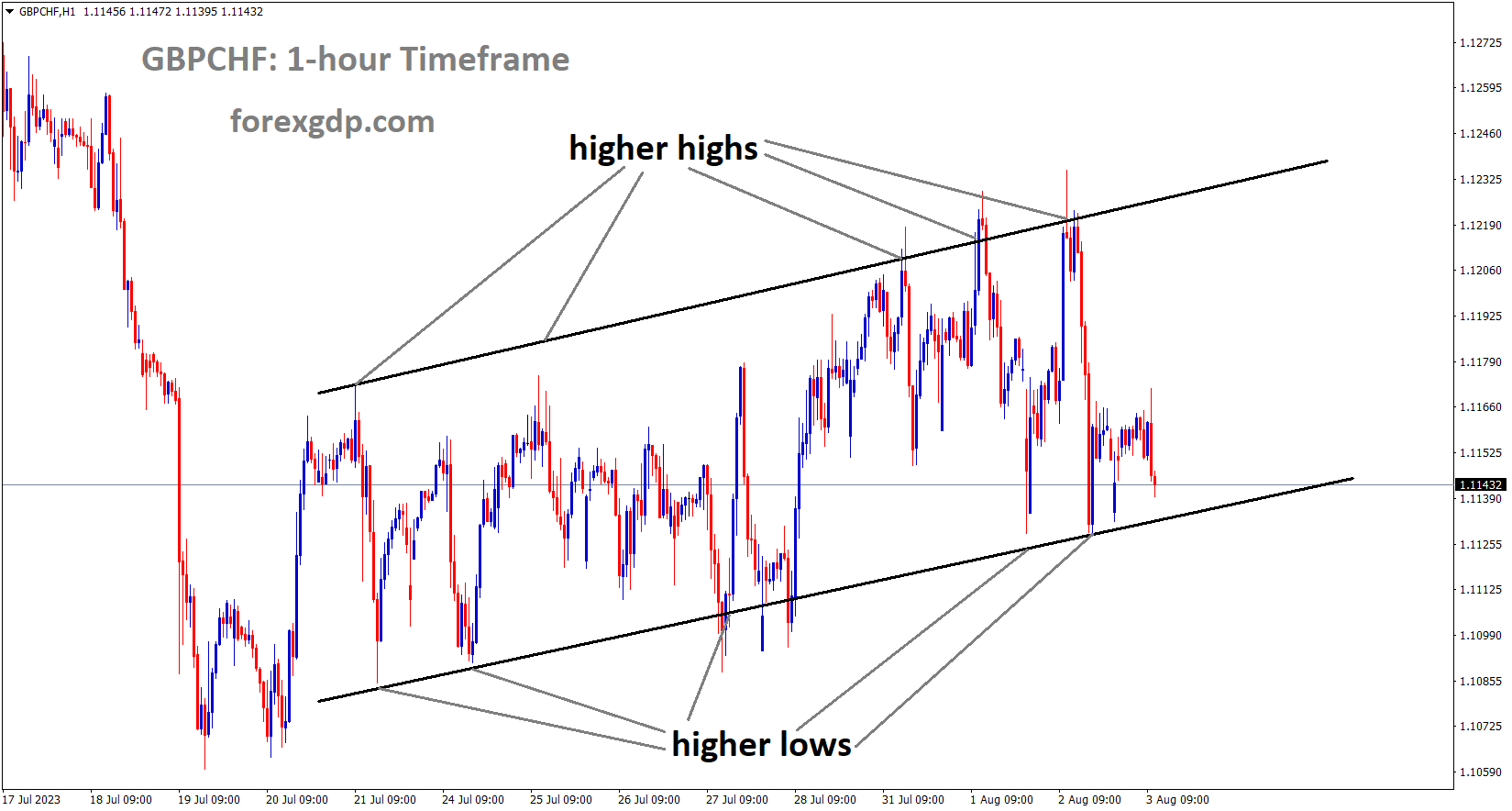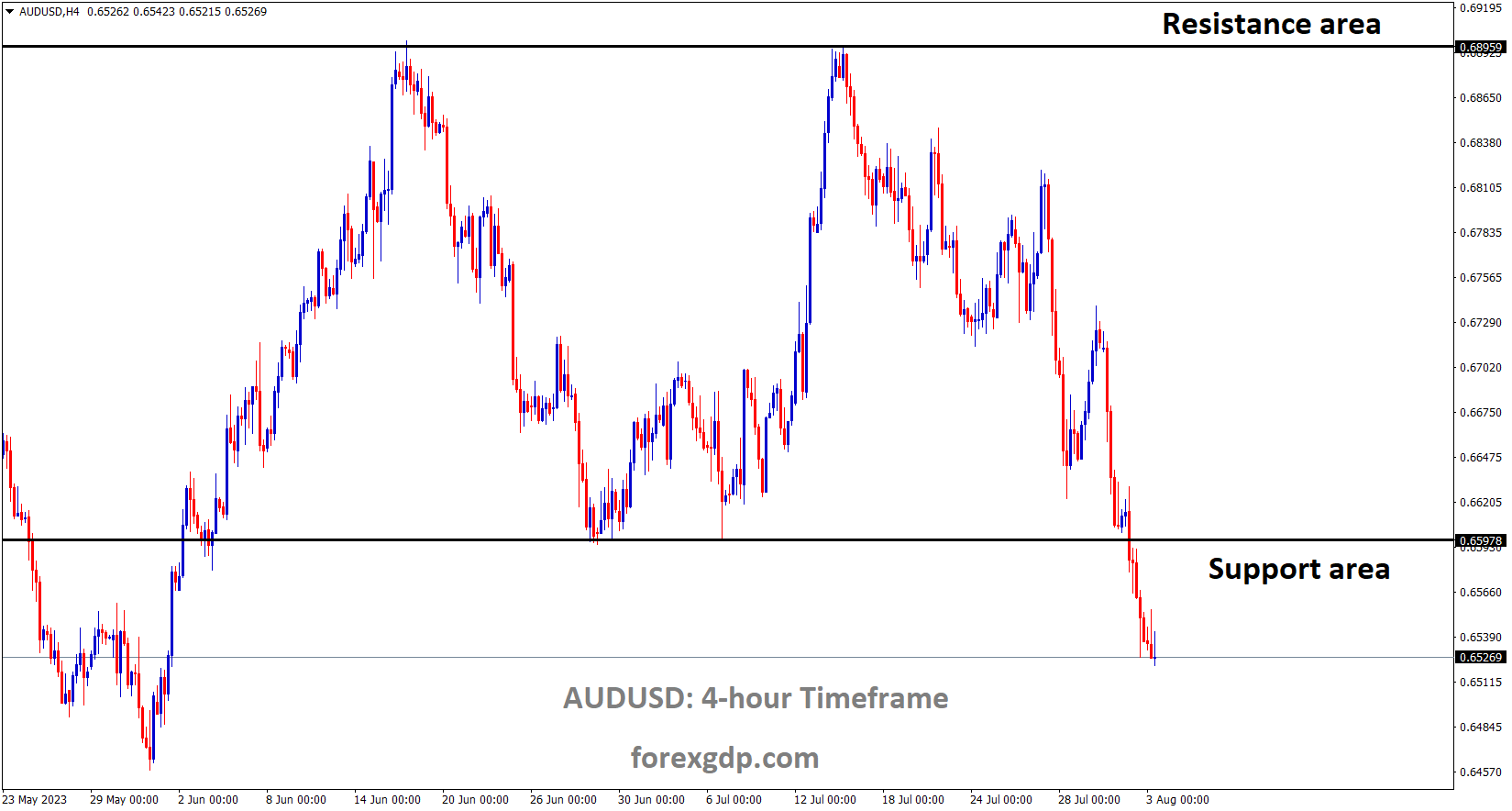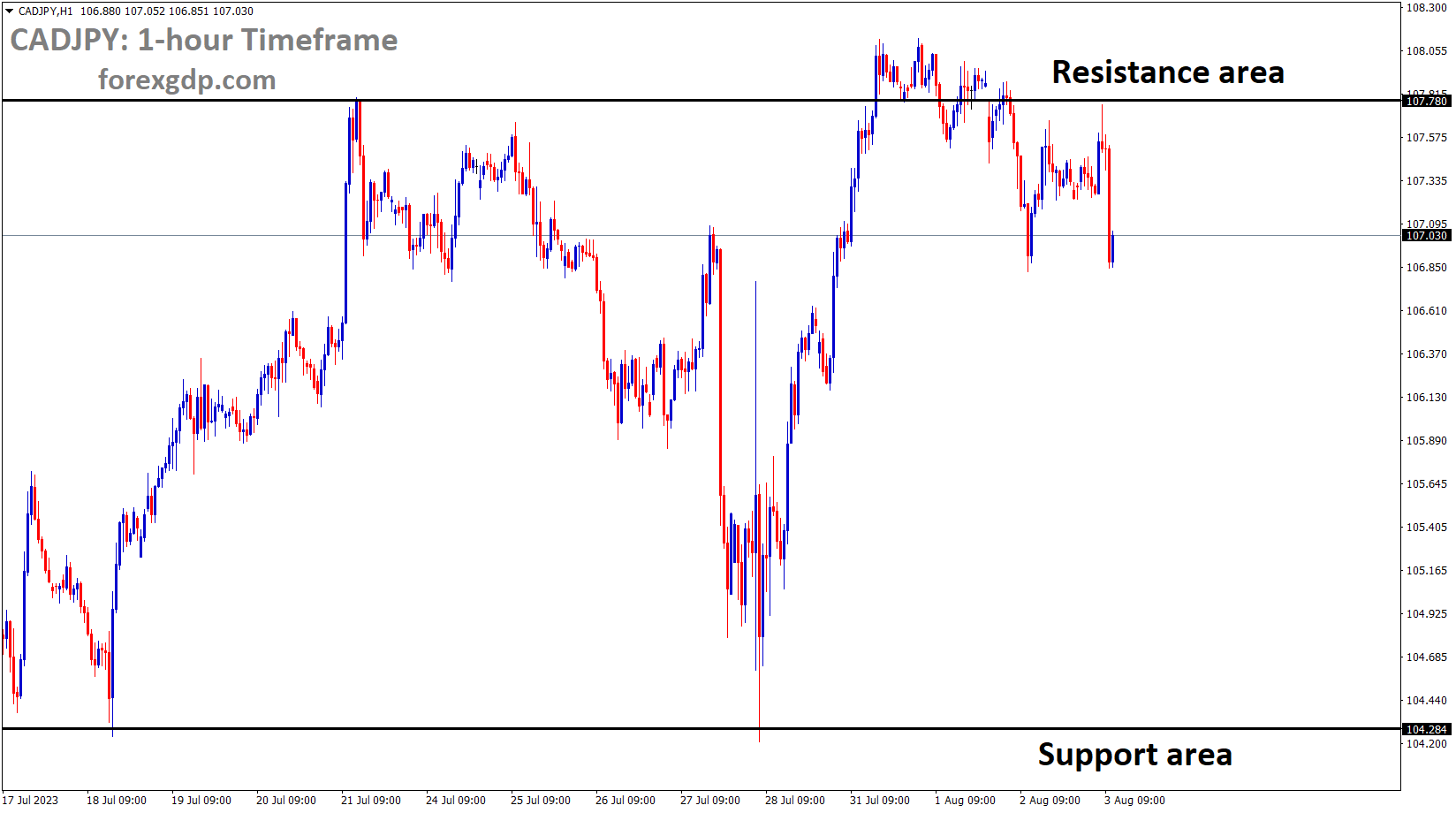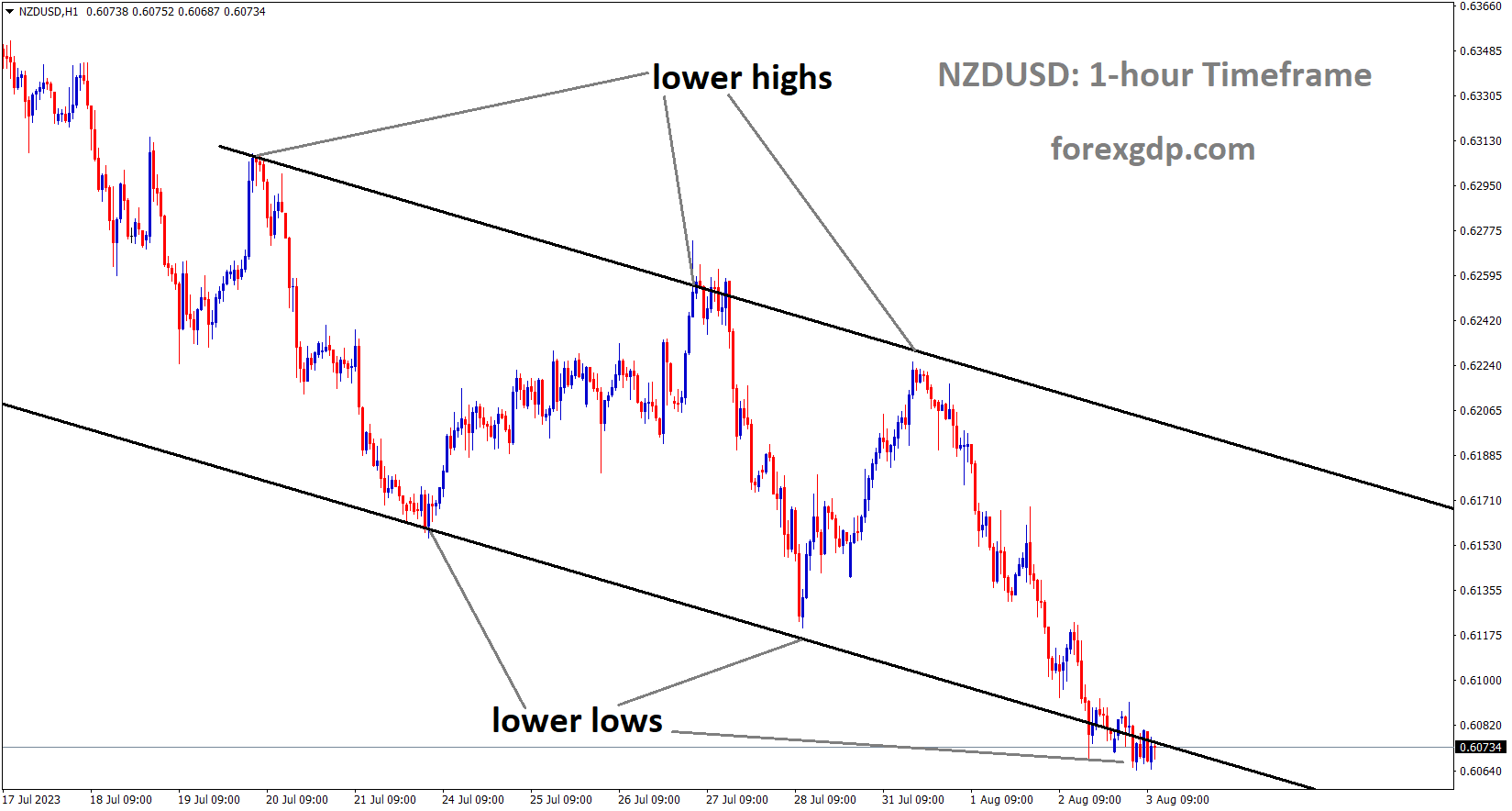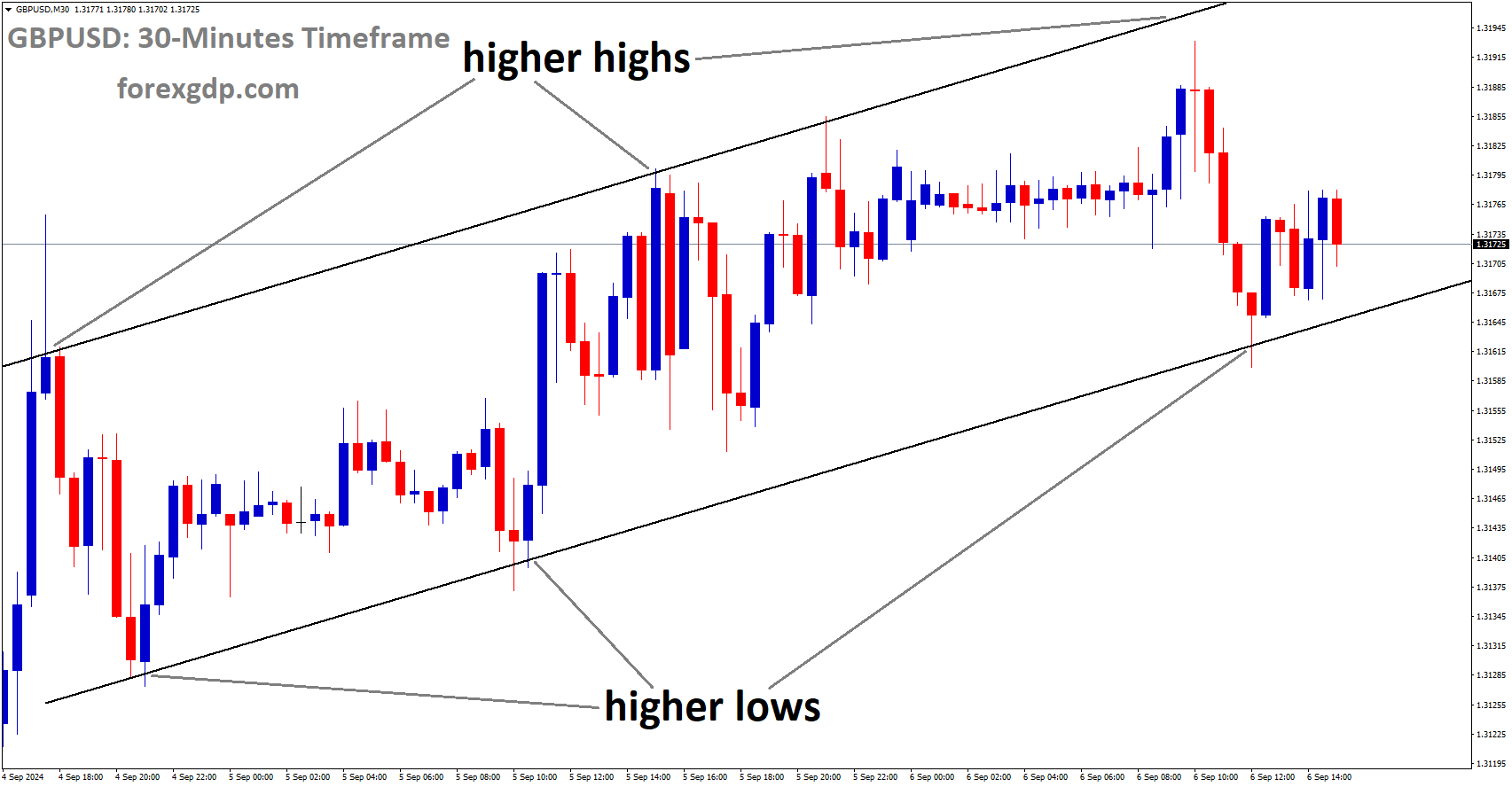USDCHF Analysis
USDCHF is moving in an Ascending channel and the market has reached the higher low area of the channel.
Swiss CPI (YoY) for July came in at 1.6%, down from 1.7% in June. Monthly reading is -0.10% as opposed to the forecasted -0.20% and the previous reading of 0.10%. The Swiss Franc is weaker than the US Dollar due to lower Swiss inflation.
As it justifies negative Swiss Inflation data for July going into Thursday’s European session, USD/CHF maintains modest gains around 0.8785-90. The Swiss Franc (CHF) pair does this while also taking cues from a stronger US Dollar and a cautious attitude in advance of the US ISM Services PMI. Despite this, the Swiss Consumer Price Index (CPI) increased 1.6% YoY in July compared to 1.7% in previous readings, which is in line with market expectations. The monthly readings, however, fall short of market expectations and the prior reading of 0.1%, coming in at -0.1%.
XAUUSD Analysis
XAUUSD Gold Price is moving in an Ascending channel and the market has reached the higher low area of the channel.
Following the US private sector’s 324000 job addition in July, which was better than anticipated, gold prices have decreased. Since November 2022, the 10-year US Treasury note has increased to 4.10%, which is a higher level. The US job market has suppressed the Fitch rating agency’s downgrading of the US dollar’s credit rating.
Due to pressure from rising nominal rates and a stronger dollar, gold prices fell again on Wednesday (XAU/USD: -0.4% to $1,936), extending losses for the second straight session. Treasury yields spiked higher during early afternoon trading, especially those at the long end of the curve, with the 10-year note reaching a high of 4.10%, its highest level since November 2022. Yields increased as a result of better-than-anticipated ADP economic data, which showed that the private sector added an astonishing 324,000 jobs in July, nearly double the consensus estimates, indicating that the labour market is still booming. Today’s bond movements were likely influenced by Fitch Ratings’ decision to downgrade U.S. debt, which led some traders to reduce their exposure to these fixed-income securities.
XAGUSD Analysis
XAGUSD Silver price has broken the Box pattern in downside.
Looking ahead, it is critical to pay close attention to Thursday morning’s ISM non-manufacturing PMI report. Wall Street analysts claim that the services sector’s business activity decreased in July from 53.9 to 53.00, which allowed the prices paid index to decrease from 54.1 to 52.1, which was a positive development for the fight against inflation. Retail investors should, however, pay close attention to the official U.S. employment survey, which will be made public on Friday morning. Following a 209,000 increase in payrolls in June, it is anticipated that U.S. employers hired 200,000 workers last month. Meanwhile, it is anticipated that the unemployment rate will remain at 3.6%.
USDCAD Analysis
USDCAD is moving in the Descending channel and the market has reached the resistance area of the minor Box pattern inside the channel.
When oil prices remain above $80, the Canadian dollar is supported. Local domestic data favourably support the Canadian Dollar when compared to other currencies.
The USDCAD pair is reportedly consolidating its recent significant gains to a four-week high and fluctuating in a constrained band around mid-1.3300s through Thursday’s Asian session. Investors now appear to be confident that the Federal Reserve Fed will maintain its hawkish stance, and the US Dollar USD is holding strong close to its highest level since July 7 was touched on Wednesday. Despite the US credit rating being downgraded by Fitch, recent positive macroeconomic data show that the US economy is remarkably resilient, which should allow the Fed to maintain higher interest rates for a longer period of time. In actuality, private-sector employers added 324K jobs in July as opposed to the 189K anticipated, according to the US ADP report released on Wednesday. This follows the positive US GDP print released last week, which confirms market expectations for further Fed policy tightening. The outlook is still favourable for the high US Treasury bond yields, which continue to support the US dollar and the USDCAD pair.
Meanwhile, a stronger USD counteracts the optimism surrounding data showing a significant decline in US oil inventories over the past week and keeps the dark liquid on the back foot for a second straight day. Recall that the US crude inventories decreased by over 17 million barrels during the week ending July 28, marking the largest drawdown seen since 1982, according to official data. This shows a significant tightening in the markets, but it does not do much to support the price of crude oil. In turn, this is perceived as weakening the Loonie, which is linked to commodities, and providing additional support for the USDCAD pair. Additionally, the overnight move back above the 50-day Simple Moving Average SMA, which has not happened since early June, indicates that the upward path for spot prices is the one that presents the least amount of resistance.Traders are now anticipating the US economic calendar, which includes the release of the weekly initial claims for unemployment insurance as usual, the ISM services PMI, and factory orders later in the early North American session. This will increase demand for the safe-haven dollar and give the USDCAD pair some momentum, along with US bond yields and the general risk sentiment. In addition, changes in oil prices should help create opportunities for short-term trading. The crucial monthly employment data from the US and Canada on Friday—commonly known as the NFP report—remain the centre of attention, though.
EURUSD Analysis
EURUSD is moving in the Descending channel and the market has reached the lower low area of the channel.
Based on positive numbers that could strengthen the Euro against the USD, the Eurozone PPI data for July is scheduled for release this week. According to the data gathered from each economy, ECB president Lagarde predicted that there will be additional rate increases.
During the early hours of Thursday’s Asia session, EURUSD oscillates around 1.0940–50 after falling to its lowest point in a month by posting a three-day downtrend the previous day. In doing so, the Euro pair captures the cautious attitude of the market in advance of a flood of data from the US and the Eurozone. It is important to note that the US Dollar’s rally the day before was supported by the risk aversion wave, positive Treasury bond yields, and an empty offering from the bloc. This led to the Euro falling to its lowest point since early July. The US Dollar’s demand for haven assets increased as a result of Fitch Ratings’ downgrade to the US government credit rating, which raised concerns about a US default and weighed on sentiment. As a result, the EURUSD pair was drowned because of its status as a risk-barometer. Along with the haven demand, the US ADP Employment Change’s positive results and an increase in Treasury bond yields also pleased the Euro bears. The US ADP Employment Change for July surpassed the 189K market expectations on Wednesday and reached 324K, while the prior readings were revised down to 455K.
However, after Fitch Ratings cited these worries as the driving force behind their downgrading of the US government credit ratings, US Treasury Secretary Janet Yellen and White House WH Economic Adviser Jared Bernstein defended the legitimacy of the US Treasury bonds and attested to the US economy’s strength. By accelerating the weekly longer-term debt issuance, the US Treasury Department raised the possibility of testing the demand for US bonds following the rating cut. The same encouraged markets to continue to be anxious and to run for risk safety. While these plays were going on, the US Dollar Index DXY soared to a three-week high and US 10-year Treasury bond yields reached their highest point since November 2022. Furthermore, the Wall Street benchmarks also showed risk aversion by closing in the red.
Future Eurozone Producer Price Index PPI data for June will be released ahead of the final July activity data on Thursday morning to pique the interest of EURUSD traders. If the EU numbers reveal positive data, the Euro pair might extend its recent losses.After that, it will be crucial to keep an eye on the US ISM Services PMI, Factory Orders, Weekly Initial Jobless Claims, quarterly readings of Nonfarm Productivity, and Unit Labour Costs to determine the next step. It is important to note that the EURUSD bears are more likely to see further declines, but it all depends on how strongly the scheduled statistics support the Federal Reserve’s Fed rate hike in September.
GBPUSD Analysis
GBPUSD is moving in the Descending channel and the market has reached the lower low area of the channel.
If the rate is raised 25 basis points today, as is expected at the BoE Monetary Policy Meeting, it will be the highest rate in the previous 15 years. The BoE must outline their projections for the economy and inflation in the monetary policy report. The US credit rating was downgraded by rating agency Fitch from AAA to AA+ with a stable outlook yesterday. The agency had hinted at the move in May, citing a “erosion of governance” and “expected fiscal deterioration over the next three years” as the reasons for it. The agency listed one of its triggers as the potential default that could occur in June of this year as a result of a political impasse over raising the debt ceiling. Markets anticipate a 25 basis point rate hike in today’s latest BoE policy decision, which traders are eagerly awaiting.
GBPCHF Analysis
GBPCHF is moving in an Ascending channel and the market has reached the higher low area of the channel.
As a result, borrowing costs in the UK would reach their highest point in 15 years. The Bank of England will also release its quarterly Monetary Policy Report, which includes the central bank’s most recent economic forecasts and inflation estimates, along with the rate decision.
AUDUSD Analysis
AUDUSD has broken the Box pattern in downside.
Today Australia Trade balance numbers came at A$11,321M versus A$11791M in the previous month. Retail sales QoQ Q2 data shows -0.50% versus -0.60% the previous month. Australian Dollar moved a negative impact on the news printed.
In the Thursday morning Asian session, the AUDUSD currency pair moves further to the downside above the 0.6500 region. Due to the weaker Australian data and the market’s risk-off attitude, the pair loses momentum for the second day in a row. The price of AUDUSD is currently around 0.6532, down 0.1% on the day. According to the most recent Australian Bureau of Statistics ABS data, the country’s trade balance was A$11.321 million, just a little less than the A$11.791 million recorded in May. Due to a decrease in China’s demand for commodities, shipments of metals, coal, and other mineral fuels all saw a 2% decrease in volume. However, a 4% decrease in imports in May more than made up for the decline in exports. Retail Sales QoQ, meanwhile, decreased from -0.6% to -0.5%. Governor of the Reserve Bank of Australia RBA, Phillip Lowe, said the decision to maintain rates gives the RBA more time to assess the effects of the interest rate increases and the outlook for the economy. To ensure that inflation returns to target in a reasonable amount of time, more monetary policy tightening might be required, but this will depend on the data and the evolving risk assessment.
It is important to note that China’s Caixin Services PMI increased from 53.9 to 54.1 in July, beating the market consensus of 52.5. The Australian Dollar AUD, a proxy for China, could gain from the positive Chinese economic data. Automatic Data Processing Inc. ADP, a company that deals with data, reported on Wednesday that the number of people employed in the US private sector increased by 324K, exceeding estimates of 189K but falling short of the revised reading of 455,000 in June. This number is higher than the 12-month median. The Federal Reserve Fed may decide to raise interest rates again this year as a result of the employment data, which would strengthen the US Dollar and work against the AUDUSD exchange rate. Later in the North American session, market participants will look for cues from the US weekly Jobless Claims, Unit Labour Costs, and ISM Service PMI. The US Nonfarm Payrolls will be the focus on Friday. It is anticipated that the US economy has generated 180,000 new jobs.
CADJPY Analysis
CADJPY is moving in the Box pattern and the market has fallen from the resistance area of the pattern.
In its previous meeting, the Bank of Japan increased the YCC control from 0.50% to a band of 1.0%. YCC adjustments, according to BoJ Deputy Governor Uchida, are not intended to be tightening measures; rather, we need to achieve inflation in a proper, sustainable, and manner. In recent months, inflation has risen due to factors including rising local demand and supply-side influences.
The Bank of Japan’s meeting minutes from last Friday shed light on the reasoning behind the choice to change the way it handles the cap on the yield on 10-year Japanese Government Bonds. Although recent information suggests that the new cap will be 1%, depending on how quickly rates rise to reach that level, the committee is now willing to allow the yield to rise above the previous cap of 0.5%. Members warned of the danger of yield curve changes being mistaken for a tightening trend. The recent tool setting was implemented to sustainably extend the current supportive policy, not to herald the beginning of policy normalisation, according to comments from Deputy Governor of the BoJ Mr. Uchida.
Although there is evidence of supply-driven influences, it is not yet clear among BoJ members that inflation is primarily being driven by demand side dynamics (increased local spending/consumption, salary increases). Conclusion: The committee continues to believe that accommodating policy is required to keep inflation sustainably above the 2% price objective.
The Bank of Japan (BoJ) acted swiftly to intervene in the nation’s bond market after yields on the benchmark 10-year Japanese Government Bonds (JGB) reached new nine-year highs near 0.65%. To stop the yield curve from rising, the Japanese central bank made unlimited purchases of JGBs with maturities between 5 and 10 years.
NZDUSD Analysis
NZDUSD is moving in the Descending channel and the market has reached the lower low area of the channel.
The unemployment rate increased and the NZD Q2 employment data came in lower than anticipated, making NZD this week weaker against USD. The direction of the NZD against the USD was decided prior to Non-Farm Payrolls.
NZDUSD is under pressure due to the USD’s ongoing strength following better data and higher US bond yields. ANZ Bank economists evaluate the outlook for New Zealand. The US Dollar Index has returned to the levels it reached in early July before it fell sharply to the year’s low due to another increase in the USD and US bond yields. Strong US ADP jobs data and bond market jitters over Fitch’s downgrade of the US credit rating are to blame, which has ironically caused the USD to strengthen. Muddy and cloudy? Of course. Local Q2 labour market data did contribute to the decline, primarily due to an increase in unemployment and a theme relating to labour supply, but the USD’s reaction to Friday’s NFP data now appears to be the major factor affecting the NZDUSD exchange rate.
Don’t trade all the time, trade forex only at the confirmed trade setups.
Get Live Free Signals now: forexgdp.com/forex-signals/

